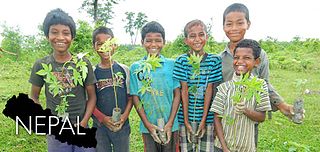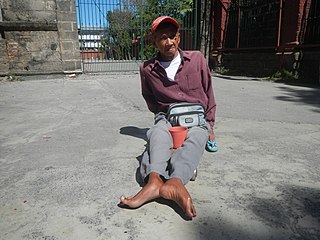
The United Nations Environment Programme (UNEP) is responsible for coordinating responses to environmental issues within the United Nations system. It was established by Maurice Strong, its first director, after the United Nations Conference on the Human Environment in Stockholm in June 1972. Its mandate is to provide leadership, deliver science and develop solutions on a wide range of issues, including climate change, the management of marine and terrestrial ecosystems, and green economic development. The organization also develops international environmental agreements; publishes and promotes environmental science and helps national governments achieve environmental targets.
The World Conference on Disaster Risk Reduction is a series of United Nations conferences focusing on disaster and climate risk management in the context of sustainable development. The World Conference has been convened three times, with each edition to date having been hosted by Japan: in Yokohama in 1994, in Hyogo in 2005 and in Sendai in 2015. As requested by the UN General Assembly, the United Nations Office for Disaster Risk Reduction (UNDRR) served as the coordinating body for the Second and Third UN World Conference on Disaster Reduction in 2005 and 2015.

Emergency management or disaster management is the managerial function charged with creating the framework within which communities reduce vulnerability to hazards and cope with disasters. Emergency management, despite its name, does not actually focus on the management of emergencies, which can be understood as minor events with limited impacts and are managed through the day-to-day functions of a community. Instead, emergency management focuses on the management of disasters, which are events that produce more impacts than a community can handle on its own. The management of disasters tends to require some combination of activity from individuals and households, organizations, local, and/or higher levels of government. Although many different terminologies exist globally, the activities of emergency management can be generally categorized into preparedness, response, mitigation, and recovery, although other terms such as disaster risk reduction and prevention are also common. The outcome of emergency management is to prevent disasters and where this is not possible, to reduce their harmful impacts.

Disaster risk reduction (DRR) is a systematic approach to identifying, assessing and reducing the risks of disaster. It aims to promote sustainable development by increasing the resilience of communities to any disasters they might face. DRR is normally used as policies intended to "define goals and objectives across different timescales and with concrete targets, indicators and time frames." The concept is also called disaster risk management (DRM).

UN-SPIDER is a platform which facilitates the use of space-based technologies for disaster management and emergency response. It is a programme under the auspices of the United Nations Office for Outer Space Affairs (UNOOSA).
Local Adaptation Plans of Action (LAPAs) are community-driven plans that aim to help local governments and communities build resilience to the impacts of climate change. LAPAs are typically developed in regions or communities that are particularly vulnerable to the effects of climate change, such as areas prone to flooding, droughts, or extreme weather events.

Climate change is a critical issue in Bangladesh as the country is one of the most vulnerable to the effects of climate change. In the 2020 edition of Germanwatch's Climate Risk Index, it ranked seventh in the list of countries most affected by climate calamities during the period 1999–2018. Bangladesh's vulnerability to the effects of climate change is due to a combination of geographical factors, such as its flat, low-lying, and delta-exposed topography, and socio-economic factors, including its high population density, levels of poverty, and dependence on agriculture. The impacts and potential threats include sea level rise, temperature rise, food crises, droughts, floods, and cyclones.

Climate finance are funding processes for investments related to climate change mitigation and adaptation. The term has been used in a narrower sense to refer to transfers of public resources from developed to developing countries, in light of their UN Climate Convention obligations to provide "new and additional financial resources". In a wider sense, the term refers to all financial flows relating to climate change mitigation and adaptation.

The United Nations Office for Disaster Risk Reduction (UNDRR) was created in December 1999 to ensure the implementation of the International Strategy for Disaster Reduction.

Globally, Nepal is ranked fourth in terms of vulnerability to climate change. Floods spread across the foothills of the Himalayas and bring landslides, leaving tens of thousands of houses and vast areas of farmland and roads destroyed. In the 2020 edition of Germanwatch's Climate Risk Index, it was judged to be the ninth hardest-hit nation by climate calamities during the period 1999 to 2018. Nepal is a least developed country, with 28.6 percent of the population living in multidimensional poverty. Analysis of trends from 1971 to 2014 by the Department of Hydrology and Meteorology (DHM) shows that the average annual maximum temperature has been increasing by 0.056 °C per year. Precipitation extremes are found to be increasing. A national-level survey on the perception-based survey on climate change reported that locals accurately perceived the shifts in temperature but their perceptions of precipitation change did not converge with the instrumental records. Data reveals that more than 80 percent of property loss due to disasters is attributable to climate hazards, particularly water-related events such as floods, landslides and glacial lake outburst floods (GLOFs).
The Sendai Framework for Disaster Risk Reduction (2015–2030) is an international document that was adopted by the United Nations (UN) member states between 14 and 18 March 2015 at the World Conference on Disaster Risk Reduction held in Sendai, Japan, and endorsed by the UN General Assembly in June 2015. It is the successor agreement to the Hyogo Framework for Action (2005–2015), which had been the most encompassing international accord to date on disaster risk reduction.

Robert Glasser is the former Special Representative of the Secretary-General for Disaster Risk Reduction, and head of the United Nations International Strategy for Disaster Reduction. Australian national Glasser was nominated in November 2015 by Secretary-General of the United Nations Ban Ki-moon to succeed Margareta Wahlström of Sweden, who was the first such Special Representative and had been appointed in November 2008. Glasser took up his post in January 2016. He was succeeded on 1 March 2018 by Mami Mizutori.
Ecosystem-based adaptation (EBA) encompasses a broad set of approaches to adapt to climate change. They all involve the management of ecosystems and their services to reduce the vulnerability of human communities to the impacts of climate change. The Convention on Biological Diversity defines EBA as "the use of biodiversity and ecosystem services as part of an overall adaptation strategy to help people to adapt to the adverse effects of climate change".

The Coalition for Disaster Resilient Infrastructure (CDRI) is an international coalition of countries, United Nations (UN) agencies, multilateral development banks, the private sector, and academic institutions, that aims to promote disaster-resilient infrastructure. Its objective is to promote research and knowledge sharing in the fields of infrastructure risk management, standards, financing, and recovery mechanisms. It was launched by the Indian Prime Minister Narendra Modi at the 2019 UN Climate Action Summit in September 2019.
The International Recovery Platform (IRP) is a joint initiative of United Nations agencies, international financial institutions, national and local governments, and non-governmental organizations engaged in disaster recovery. IRP was founded in 2005. It came after the Second World Conference on Disaster Reduction, to support implementation of the Hyogo Framework for Action (HFA). The group works to identify and address gaps in recovery knowledge, practice and constraints. In 2015, IRP aligned its work to support implementation of the newly adopted Sendai Framework for Disaster Risk Reduction. It concentrated on Priority Four – building back better in recovery, rehabilitation and reconstruction.
Building Back Better (BBB) is a strategy aimed at reducing the risk to the people of nations and communities in the wake of future disasters and shocks. The BBB approach integrates disaster risk reduction measures into the restoration of physical infrastructure, social systems and shelter, and the revitalisation of livelihoods, economies and the environment.

Sustainable Development Goal 13 is to limit and adapt to climate change. It is one of 17 Sustainable Development Goals established by the United Nations General Assembly in 2015. The official mission statement of this goal is to "Take urgent action to combat climate change and its impacts". SDG 13 and SDG 7 on clean energy are closely related and complementary.

Sustainable Development Goal 11, titled "sustainable cities and communities", is one of 17 Sustainable Development Goals established by the United Nations General Assembly in 2015. The official mission of SDG 11 is to "Make cities inclusive, safe, resilient and sustainable". The 17 SDGs take into account that action in one area will affect outcomes in other areas as well, and that development must balance social, economic and environmental sustainability.

Climate change disproportionately affects individuals with disabilities, both directly and indirectly. Individuals with disabilities are more likely to experience the effects of climate change on humans more acutely compared to those without disabilities. Typically, disabled people are the most likely to be negatively affected by any form of emergency, whether it be an immediate emergency like a flood or tornado or a gradual emergency like rising sea levels, due to a lack of access to emergency resources and the difficulties imposed by limited mobility. Disabled people are also more adversely affected by climate change because a disproportionate number of disabled people live in poverty, and people living in poverty are inherently more at risk due to climate change. Despite this, and despite the fact that disabled people make up more than 15% of the global population, they have had minimal input and involvement in the decision-making process surrounding responses to climate change. A 2022 study by the Disability-Inclusive Climate Action Research Programme revealed that only 37 of 192 State Parties to the Paris Agreement currently refer to persons with disabilities in their nationally determined contributions, while only 46 State Parties refer to persons with disabilities in their domestic climate adaptation policies.

Climate change adaptation in the Philippines is being incorporated into development plans and policies that specifically target national and local climate vulnerabilities. As a developing country and an archipelago, the Philippines is particularly vulnerable to a variety of climatic threats like intensifying tropical cyclones, drastic changes in rainfall patterns, rising sea levels, and rising temperatures. According to the UN Office for the Coordination of Humanitarian Affairs (OCHA), the Philippines is one of the most disaster-prone countries in the world. In 2021, the Global Climate Risk Index ranked the Philippines fourth of the ten countries most affected between the years 2000 and 2019. The need for managing climate risks through climate change adaptation has become increasingly evident. Adaptation can reduce, moderate or avoid current and expected climate effects or take advantage of beneficial climatic events. Developing greater resilience to various threats can be a major goal of comprehensive disaster risk reduction strategy. The Philippines is therefore working on a number of national and local adaptation and disaster risk reduction strategies to build the country's climate resilience.














